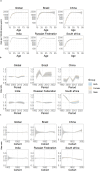Epidemiological trends and age-period-cohort effects on periodontal diseases incidence across the BRICS from 1992 to 2021
- PMID: 40140797
- PMCID: PMC11938746
- DOI: 10.1186/s12903-025-05796-8
Epidemiological trends and age-period-cohort effects on periodontal diseases incidence across the BRICS from 1992 to 2021
Abstract
Background: Periodontal diseases are prevalent oral conditions, particularly burdensome in developing countries. This study examines global and BRICS countries' changing trends in periodontal diseases incidence from 1992 to 2021, focusing on associations with age, period, and cohort effects.
Materials and methods: A cross-sectional burden of disease study was conducted. Data on the total population and periodontal diseases cases, all-age incidence rate, age-standardized incidence rate, and relative change in periodontal diseases incidence from 1992 to 2021 within BRICS were obtained from the Global Burden of Disease study (GBD) 2021. Furthermore, the Age-Period-Cohort (APC) model with an intrinsic estimator (IE) algorithm was employed to assess the effects of net drift, local drift, age, period, and cohort on the incidence rates of periodontal diseases over specific time periods.
Results: Globally, the new cases of periodontal diseases in 2021 were reported at 8961 thousand (95% uncertainty intervals: 7907, 10101), reflecting a 71.21% increase compared to 1992. In 2021, the age-standardized incidence rate of periodontal diseases across the BRICS countries ranged from 600.50 (95% uncertainty intervals: 481.27, 763.54) per 100,000 population in South Africa to 1268.96 (95% uncertainty intervals: 1119.16, 1409.94) per 100,000 population in India. The age distribution of periodontal diseases cases was relatively stable globally and among BRICS countries from 1992 to 2021. Countries exhibited similar age-effect patterns, with increasing risk with increasing age, and varying period and cohort effects, indicative of differential control measures and temporal incidence trends.
Conclusions: Brazil, India, and China experienced an increasing trend in the age-standardized incidence rates of periodontal diseases from 1992 to 2021, in contrast to the declining trends observed in the Russian Federation and South Africa. Furthermore, the APC analysis indicates the intricate dynamics of age, period, and cohort influences on periodontal diseases incidence. Distinct national trajectories, shaped by varying socioeconomic, cultural, and historical frameworks, highlight that public health initiatives must be meticulously customized to mitigate and control the periodontal diseases burden across diverse settings.
Keywords: Age-period-cohort; BRICS; Incidence; Periodontal diseases; Trend.
© 2025. The Author(s).
Conflict of interest statement
Declarations. Ethics approval and consent to participate: Not applicable. Consent for publication: Not applicable. Competing interests: The authors declare no competing interests.
Figures


Similar articles
-
Time trends in anxiety disorders incidence across the BRICS: an age-period-cohort analysis for the GBD 2021.Front Public Health. 2024 Oct 7;12:1467385. doi: 10.3389/fpubh.2024.1467385. eCollection 2024. Front Public Health. 2024. PMID: 39435408 Free PMC article.
-
Time trends in maternal hypertensive disorder incidence in Brazil, Russian Federation, India, China, and South Africa (BRICS): an age-period-cohort analysis for the GBD 2021.BMC Pregnancy Childbirth. 2024 Nov 8;24(1):731. doi: 10.1186/s12884-024-06931-z. BMC Pregnancy Childbirth. 2024. PMID: 39516729 Free PMC article.
-
Time trends in subarachnoid haemorrhage mortality across the BRICS (Brazil, Russian Federation, India, China and South Africa): an age-period-cohort analysis for the GBD 2021.BMJ Open. 2025 Mar 18;15(3):e092000. doi: 10.1136/bmjopen-2024-092000. BMJ Open. 2025. PMID: 40107678 Free PMC article.
-
Epidemiological trends and age-period-cohort effects on ischemic stroke burden across the BRICS-plus from 1992 to 2021.BMC Public Health. 2025 Jan 13;25(1):137. doi: 10.1186/s12889-025-21310-9. BMC Public Health. 2025. PMID: 39806358 Free PMC article.
-
Time trends in thermal burns incidence among Brazil, Russia, India, China, and South Africa (BRICS), an age-period-cohort analysis from the GBD 2019.Sci Rep. 2025 Feb 26;15(1):6877. doi: 10.1038/s41598-025-90935-y. Sci Rep. 2025. PMID: 40011583 Free PMC article.
References
-
- GBD 2021 Diseases and Injuries Collaborators. Global incidence, prevalence, years lived with disability (YLDs), disability-adjusted life-years (DALYs), and healthy life expectancy (HALE) for 371 diseases and injuries in 204 countries and territories and 811 subnational locations, 1990–2021: a systematic analysis for the global burden of disease study 2021. Lancet (London England). 2024;403(10440):2133–61. - PMC - PubMed
-
- Peres MA, Macpherson LMD, Weyant RJ, Daly B, Venturelli R, Mathur MR, Listl S, Celeste RK, Guarnizo-Herreño CC, Kearns C, et al. Oral diseases: a global public health challenge. Lancet. 2019;394(10194):249–60. - PubMed
-
- Ghaffari M, Rakhshanderou S, Ramezankhani A, Noroozi M, Armoon B. Oral health education and promotion programmes: Meta-Analysis of 17-Year intervention. Int J Dental Hygiene. 2018;16(1):59–67. - PubMed
-
- Trindade D, Carvalho R, Machado V, Chambrone L, Mendes JJ, Botelho J. Prevalence of periodontitis in dentate people between 2011 and 2020: A systematic review and meta-analysis of epidemiological studies. J Clin Periodontol. 2023;50(5):604–26. - PubMed
-
- Pattamatta M, Chapple I, Listl S. The value-for money of preventing and managing periodontitis: Opportunities and challenges. Periodontology 2000. 2024. - PubMed
MeSH terms
Grants and funding
LinkOut - more resources
Full Text Sources

